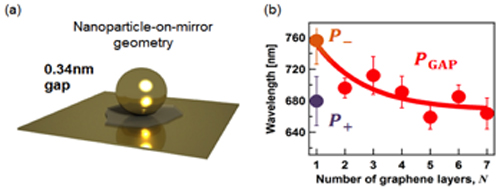Submitted by Dr Nalin Patel on Wed, 18/12/2013 - 14:00
Winton Scholar Jan Mertens describes how graphene has been used as a spacer with atomic thickness precision to modify plasmonic modes
Today`s technology is based on miniaturised structures to realise high performance devices. Nanostructured systems become ever more important. However, processes on these tiny lengths scales are not yet well understood. In the presented research, the optical properties of gaps between metallic nanostructures with a thickness of just one atomic layer are studied. In such gaps, light fields are strongly localised due to coupled plasmonic resonances. These strong fields are used in sensing applications to enhance weak signals like vibrational motion of molecules.
In our study, published in NanoLetters, sub-nanometer gaps in plasmonic dimers are created using monolayers of graphene. Graphene enables us to form a stable, robust, and controlled junction between individual 80 nm gold nanoparticles (AuNP) and a gold substrate (Fig. 1a). We create gaps with digital spacer layers of 0.34 nm, thus reaching the limit of a single atom spacer.

Figure 1 (a) Schematic of AuNP on single graphene layer with image in Au surface. (b) Resonance of coupled plasmonic modes vs. graphene layers.
Plasmonic resonances are observed using white light spectroscopy in dark field configuration. For separations defined by a single layer of graphene, we observe a split in the plasmonic resonance (Fig. 1b). The gap`s geometry and the junction`s resistivity define the value of the splitting. With increasing number of graphene layers, the conductivity of the gap decreases so that the splitting vanishes and a plasmonic resonance in close proximity to the junction, a gap plasmon, remains which is shifting to the blue. Due to the high spectral sensitivity to electronic properties of the spacer material, this system can be used to characterise electronic properties of other two dimensional-crystals used as spacer materials. Furthermore, tuning of plasmonic resonances can be achieved optically or by electronic gating of the spacer material.
Our work is mentioned in Nature Nanotechnology as a research highlight and press releases can be found in Nanowerk and Nanowebtech.

